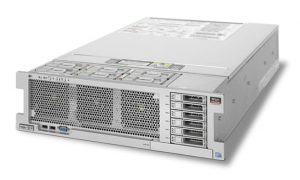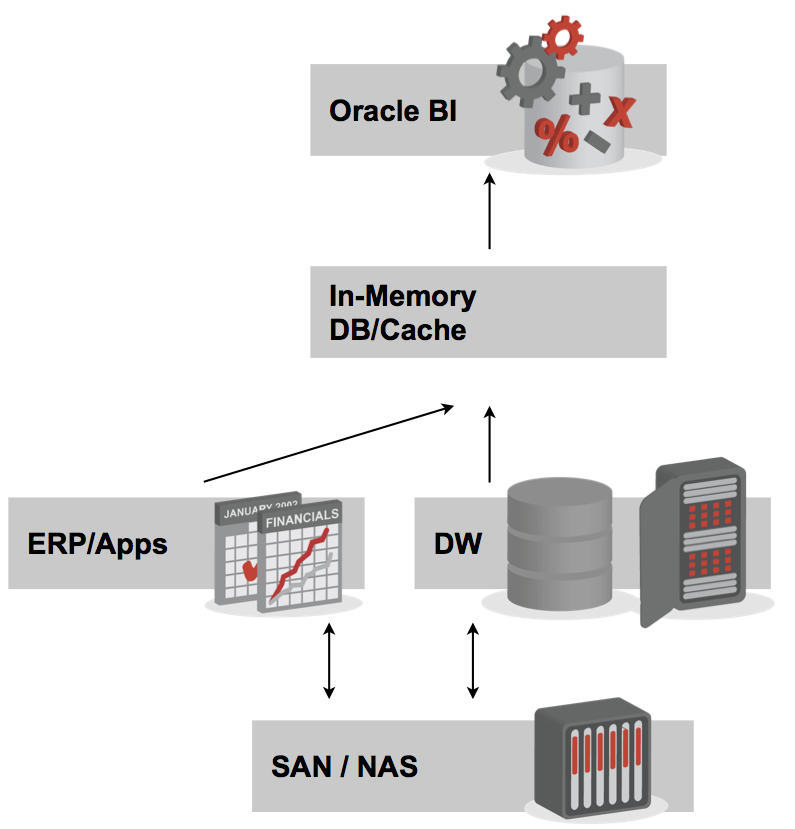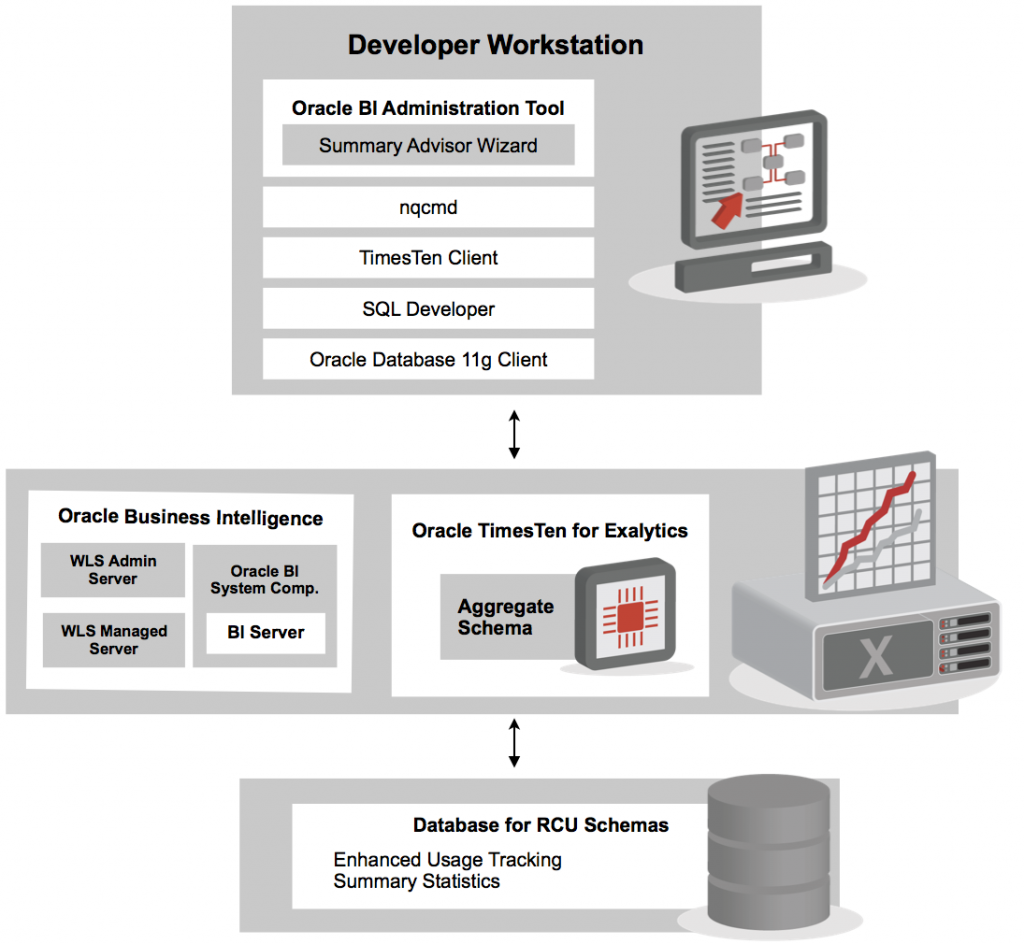Oracle Exalytics Week : Introducing Oracle Exalytics In-Memory Machine
In the first post in this Oracle Exalytics week series, we looked BI in general and how users wanted fast, consistent response times from their dashboards and reports. The are several potential solutions for improving query performance including adding materialized views and indexes, using MOLAP technologies such as Oracle Essbase and Oracle OLAP, or you can invest in one or more Exadata boxes to make light work of sifting through and aggregating very large datasets. But all of these approaches have their own limitations, and they still aren't going to guarantee your users consistent, sub-second response times for their dashboards. One other potential solution to this problem is to use in-memory technology, and this is the basis of Oracle's newest Exa-family engineered system - Oracle Exalytics In-Memory Machine. Before we go on, here's a recap of our Exalytics week agenda, and I'll update this list as we add each post during the week:
- Oracle Exalytics Week : The Case for Exalytics
- Oracle Exalytics Week : Introducing Oracle Exalytics In-Memory Machine
- Oracle Exalytics Week : Exalytics & TimesTen - Under the Covers
- Oracle Exalytics Week : The Summary Advisor
- Oracle Exalytics Week : How Does it Perform, and How can I Test It?
So what is Exalytics? Like Exadata and Exalogic, Exalytics is a combination of hardware and software, with the software containing special capabilities that you can't get just by assembling your own system, using off-the-shelf components. Here's the highlights from the product specs:

- Exalytics (or Oracle Exalytics In-Memory Machine to give it it's full title) is based on a Sun server containing Four Xeon E7-4800 series processors, for 40 cores in total
- The server has 1TB of RAM, made up of 64 16GB DDR3 ECC registered DIMMs
- There's QDR (40Gb/second) InfiniBand connectivity to Exadata & Exalogic, and 10Gb and 1Gb Ethernet interfaces
- ... and 3.6TB of HDD, which is generally reserved for the OS, software plus in-memory caches
- For the software element, there's a special version of Oracle Business Intelligence Enterprise Edition 11.1.1.6
- and TimesTen for Exalytics, a special version of Oracle's in-memory database
- Essbase is also included, as part of Oracle BI Foundation, again with special in-memory and Exalytics optimizations
- Exalytics is sold as a complete system, so the software and hardware are sold together, and optimized for each other
Exalytics then sits in-between your data, and your users' dashboards, providing a high-performance, low-latency data store that powers their reporting.

By giving the server 40 CPU cores, you immediately increase the amount of concurrent users the BI element of your system can handle, and you also make it possible to create new types of analyses that display data in a far more dense, visualization-rich manner. In addition, because Oracle have engineered both the hardware, and the software, it's now possible to create optimizations in OBIEE and Essbase that assume 40 cores, 1TB of RAM and a certain server performance profile, again potentially improving performance and creating a more real-time, exploratory environment for end-users.

Exalytics, product and version-specifically, contains the following hardware and software elements:
- Sun Fire X4470 M2 server with 1TB RAM, 40 cores and 3.6TB of HDD
- OBIEE 11.1.1.6 with Exalytics Enhancements
- Oracle Essbase 11.1.2 with Exalytics Enhancements
- Oracle TimesTen 11.2.2.2 for Exalytics
- Oracle Linux 64-bit, the same version/distribution as used for Exalogic
License-wise, there are three things you license or buy as part of Exalytics:
- Oracle BI Foundation Suite, typically named used (100 user minimum), but also available per-CPU
- Oracle TimesTen In-Memory Database
- The Sun Fire X4470 M2 server, but as part of the Exalytics package
If you're already on OBIEE and want to upgrade to Exalytics, upgrade deals are possible - drop us a line and we'll explain how it works. But for now, what's the architecture for Exalytics itself?
Exalytics consists mainly of server elements, with client tools also installed on your developer/administration workstation. The Exalytics server runs 64-bit Oracle Linux, and has OBIEE including WebLogic Server installed, along with Oracle TimesTen for Exalytics and Essbase (not shown on the diagram).

There's no database on the Exalytics server, so you'll need another server and a database to hold the repository schemas created by the Repository Creation Utility, and you'll also need to connect to your data sources, which could be over ethernet or over the Infiniband connection, if you're using Exadata. Several Exalytics boxes can be "daisy-chained" together also using Infiniband to give you high-availability, and the Exalytics box can be managed by Oracle's ILOM (Integrated Lights-Out Management) to allow remote management. Finally, the Oracle BI Administration tool, complete with new Exalytics extensions, is then installed on your workstation, along with tools such as Oracle SQL*Developer, the TimesTen client, and an Oracle database client.
So, now we've covered the basics of the product, what's the "secret sauce" to how Exalytics work, and how does TimesTen work as the in-memory layer? Check out tomorrow's posting for more details.